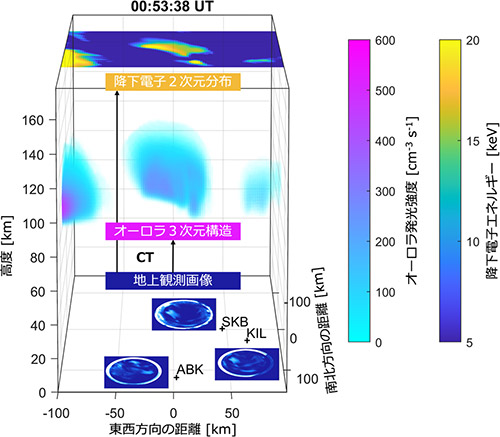2022-08-25 カリフォルニア大学バークレー校(UCB)
火成岩の結晶構造は、シエラネバダの花崗岩に似ているが、組成が異なり、はるかに細粒である。ミリメートルサイズのカンラン石の粒が輝石と混在しており、ゆっくりとした冷却によってのみ形成されたことがわかる。この粗粒のカンラン石は、火星に起源を持ち、最終的に地球に衝突したと考えられている隕石の一部に見られるものと類似している。この結果は、ペルセバランスに搭載された装置によるマルチスペクトル画像と蛍光X線分析から得られたものである。
マーズ(ナバホ族の言葉で火星)と呼ばれる近くの2番目の場所からのサンプルも火成岩ですが、組成が異なります。この層はSéítahで露出した火成岩の層の上にあるので、Máazの岩はマグマ湖の上層部であった可能性がある。
Séítahのゆっくり冷えた岩石も、Máazの急速に冷えた岩石も、異なる方法ではあるが、水による変質を示していた。探査機に搭載された化学分析によると、マーズの岩石には塩分を含んだ塩水が凝縮した可能性のある鉱物のポケットがあり、セイタの岩石は炭酸水と反応したことが判明した。
<関連情報>
- https://news.berkeley.edu/2022/08/25/perseverance-rover-retrieves-key-clues-to-mars-geologic-and-water-history/
- https://www.science.org/doi/10.1126/science.abo2196
- https://www.science.org/doi/10.1126/science.abo2756
火星ジェゼロクレーターの底で採取された水性変質した火成岩 Aqueously altered igneous rocks sampled on the floor of Jezero crater, Mars
K. A. Farley,K. M. Stack ,D. L. Shuster ,B. H. N. Horgan ,J. A. Hurowitz ,J. D. Tarnas ,J. I. Simon,V. Z. Sun ,E. L. Scheller ,K. R. Moore,S. M. McLennan ,P. M. Vasconcelos,R. C. Wiens ,A. H. Treiman ,L. E. Mayhew ,O. Beyssac ,T. V. Kizovski ,N. J. Tosca ,K. H. Williford,L. S. Crumpler ,L. W. Beegle ,J. F. Bell III ,B. L. Ehlmann ,Y. Liu ,J. N. Maki ,M. E. Schmidt ,A. C. Allwood,H. E. F. Amundsen,R. Bhartia ,T. Bosak ,A. J. Brown ,B. C. Clark ,A. Cousin ,O. Forni ,T. S. J. Gabriel ,Y. Goreva ,S. Gupta ,S.-E. Hamran ,C. D. K. Herd ,K. Hickman-Lewis ,J. R. Johnson ,L. C. Kah ,P. B. Kelemen ,K. B. Kinch ,L. Mandon ,N. Mangold ,C. Quantin-Nataf ,M. S. Rice ,P. S. Russell,S. Sharma ,S. Siljeström ,A. Steele ,R. Sullivan ,M. Wadhwa ,B. P. Weiss ,A. J. Williams ,B. V. Wogsland ,P. A. Willis ,T. A. Acosta-Maeda,P. Beck ,K. Benzerara ,S. Bernard ,A. S. Burton ,E. L. Cardarelli ,B. Chide ,E. Clavé ,E. A. Cloutis ,B. A. Cohen ,A. D. Czaja ,V. Debaille,E. Dehouck ,A. G. Fairén ,D. T. Flannery ,S. Z. Fleron ,T. Fouchet ,J. Frydenvang ,B. J. Garczynski ,E. F. Gibbons ,E. M. Hausrath ,A. G. Hayes ,J. Henneke ,J. L. Jørgensen ,E. M. Kelly ,J. Lasue ,S. Le Mouélic ,J. M. Madariaga ,S. Maurice ,M. Merusi ,P.-Y. Meslin ,S. M. Milkovich,C. C. Million ,R. C. Moeller,J. I. Núñez ,A. M. Ollila ,G. Paar ,D. A. Paige,D. A. K. Pedersen ,P. Pilleri ,C. Pilorget ,P. C. Pinet,J. W. Rice Jr.,C. Royer ,V. Sautter,M. Schulte ,M. A. Sephton ,S. K. Sharma ,S. F. Sholes ,N. Spanovich ,M. St. Clair ,C. D. Tate,K. Uckert ,S. J. VanBommel ,A. G. Yanchilina ,M.-P. Zorzano
Science Published:25 Aug 2022
DOI: 10.1126/science.abo2196

RELATED RESEARCH ARTICLE
Compositionally and density stratified igneous terrain in Jezero crater, Mars
RELATED RESEARCH ARTICLE
Ground penetrating radar observations of subsurface structures in the floor of Jezero crater, Mars
Abstract
The Perseverance rover landed in Jezero crater, Mars, to investigate ancient lake and river deposits. We report observations of the crater floor, below the crater’s sedimentary delta, finding the floor consists of igneous rocks altered by water. The lowest exposed unit, informally named Séítah, is a coarsely crystalline olivine-rich rock, which accumulated at the base of a magma body. Fe-Mg carbonates along grain boundaries indicate reactions with CO2-rich water, under water-poor conditions. Overlying Séítah is a unit informally named Máaz, which we interpret as lava flows or the chemical complement to Séítah in a layered igneous body. Voids in these rocks contain sulfates and perchlorates, likely introduced by later near-surface brine evaporation. Core samples of these rocks were stored aboard Perseverance for potential return to Earth.
火星ジェゼロクレーターの底にあるカンラン石積みの露頭 An olivine cumulate outcrop on the floor of Jezero crater, Mars
Y. Liu,M. M. Tice ,M. E. Schmidt ,A. H. Treiman,T. V. Kizovski ,J. A. Hurowitz ,A. C. Allwood,J. Henneke ,D. A. K. Pedersen ,S. J. VanBommel ,M. W. M. Jones,A. L. Knight ,B. J. Orenstein ,B. C. Clark ,W. T. Elam,C. M. Heirwegh,T. Barber,L. W. Beegle ,K. Benzerara ,S. Bernard,O. Beyssac,T. Bosak ,A. J. Brown ,E. L. Cardarelli ,D. C. Catling ,J. R. Christian ,E. A. Cloutis ,B. A. Cohen ,S. Davidoff ,A. G. Fairén ,K. A. Farley,D. T. Flannery ,A. Galvin,J. P. Grotzinger ,S. Gupta ,J. Hall ,C. D. K. Herd ,K. Hickman-Lewis ,R. P. Hodyss ,B. H. N. Horgan ,J. R. Johnson ,J. L. Jørgensen ,L. C. Kah ,J. N. Maki ,L. Mandon ,N. Mangold ,F. M. McCubbin ,S. M. McLennan ,K. Moore,M. Nachon ,P. Nemere,L. D. Nothdurft ,J. I. Núñez ,L. O’Neil ,C. M. Quantin-Nataf,V. Sautter,D. L Shuster,K. L. Siebach ,J. I. Simon ,K. P. Sinclair ,K. M. Stack ,A. Steele ,J. D. Tarnas ,N. J. Tosca ,K. Uckert ,A. Udry ,L. A. Wade,B. P. Weiss ,R. C. Wiens ,K. H. Williford,M.-P. Zorzano
Science Published:25 Aug 2022
DOI: 10.1126/science.abo2756

RELATED RESEARCH ARTICLE
Compositionally and density stratified igneous terrain in Jezero crater, Mars
RELATED RESEARCH ARTICLE
Ground penetrating radar observations of subsurface structures in the floor of Jezero crater, Mars
Abstract
The geological units on the floor of Jezero crater, Mars, are part of a wider regional stratigraphy of olivine-rich rocks, which extends well beyond the crater. We investigate the petrology of olivine and carbonate-bearing rocks of the Séítah formation in the floor of Jezero. Using multispectral images and x-ray fluorescence data, acquired by the Perseverance rover, we performed a petrographic analysis of the Bastide and Brac outcrops within this unit. We find that these outcrops are composed of igneous rock, moderately altered by aqueous fluid. The igneous rocks are mainly made of coarse-grained olivine, similar to some Martian meteorites. We interpret them as an olivine cumulate, formed by settling and enrichment of olivine through multi-stage cooling of a thick magma body.



